[one_third valign=”top” animation=”none”]
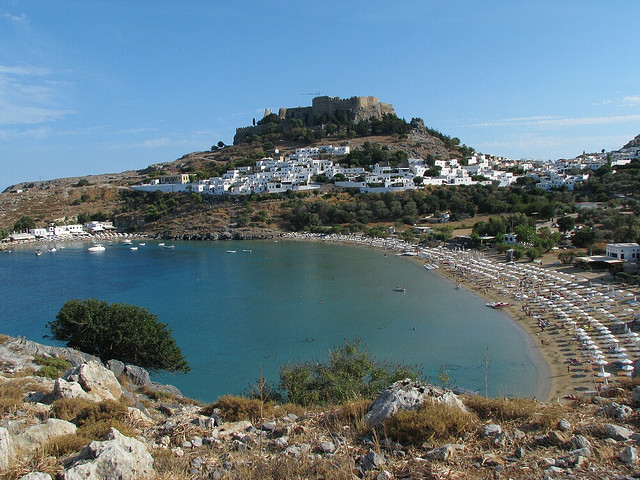
Find Best Hotel Deals in Rhodes!
[/one_third]
[two_third_last valign=”top” animation=”none”]
Lindos
Lindos is an archaeological site, a town and a former municipality on the island of Rhodes, in the Dodecanese, Greece. Since the 2011 local government reform it is part of the municipality Rhodes, of which it is a municipal unit. It lies on the east coast of the island. It is about 50 km south of the town of Rhodes and its fine beaches makes it a popular tourist and holiday destination. Lindos is situated in a large bay and faces the fishing village and small resort of Haraki. Lindos was founded by the Dorians led by the king Tlepolemus of Rhodes, who arrived in about the 10th century BC. It was one of six Dorian cities in the area known as the Dorian Hexapolis. The eastern location of Rhodes made it a natural meeting place between the Greeks and the Phoenicians, and by the 8th century Lindos was a major trading centre. Its importance declined after the foundation of the city of Rhodes in the late 5th century. In classical times the acropolis of Lindos was dominated by the massive temple of Athena Lindia, which attained its final form in around 300 BC. In Hellenistic and Roman times the temple precinct grew as more buildings were added. In early medieval times these buildings fell into disuse, and in the 14th century they were partly overlaid by a massive fortress built on the acropolis by the Knights of St John to defend the island against the Ottomans.
[/two_third_last]
[one_third valign=”top” animation=”none”]
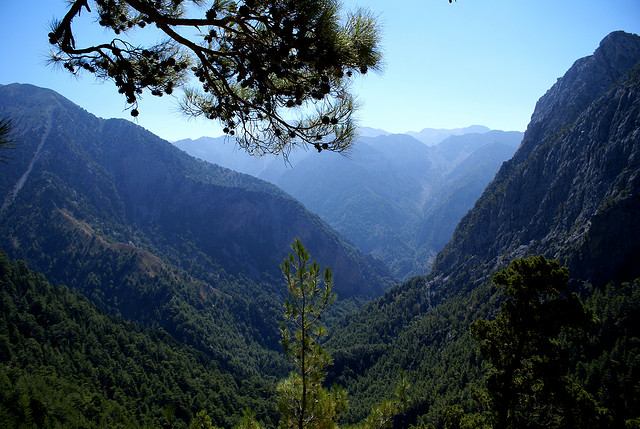
Find Best Hotel Deals in Crete!
[/one_third]
[two_third_last valign=”top” animation=”none”]
Samaria Gorge
The Samariá Gorge is a National Park of Greece on the island of Crete – a major tourist attraction of the island – and a World’s Biosphere Reserve.
The gorge is in southwest Crete in the regional unit of Chania. It was created by a small river running between the White Mountains (Lefká Óri) and Mt. Volakias. There are a number of other gorges in the White Mountains. While some say that the gorge is 18 km long, this distance refers to the distance between the settlement of Omalos on the northern side of the plateau and the village of Agia Roumeli. In fact, the gorge is 16 km long, starting at an altitude of 1,250 m at the northern entrance, and ending at the shores of the Libyan Sea in Agia Roumeli. The walk through Samaria National Park is 13 km long, but one has to walk another three kilometers to Agia Roumeli from the park exit, making the hike 16 km long. The most famous part of the gorge is the stretch known as the Gates (or, albeit incorrectly, as “Iron Gates”), where the sides of the gorge close in to a width of only four meters and soar up to a height of almost 300 meters (980 feet). The gorge became a national park in 1962, particularly as a refuge for the rare kri-kri (Cretan goat), which is largely restricted to the park and an island just off the shore of Agia Marina. There are several other endemic species in the gorge and surrounding area, as well as many other species of flowers and birds.
The village of Samariá lies just inside the gorge. It was finally abandoned by the last remaining inhabitants in 1962 to make way for the park. The village and the gorge take their names from the village’s ancient church, Óssia María.
A must for visitors to Crete is to complete the walk down the gorge from the Omalos plateau to Agia Roumeli on the Libyan Sea, at which point tourists sail to the nearby village of Sougia or Hora Sfakion, where they could spend a night there, or they could catch a coach back to Chania. The walk takes five to seven hours and can be strenuous, especially at the peak of summer.
Local tourist operators provide organized tours to the Gorge. These include bus transportation from one’s hotel to the entrance (near Omalos village), and a bus connection that will be waiting for hikers after they disembark the ferry in Sougia or Sfakia (Chora Sfakion). If you are on your own, you can make a one-day round trip from Chania (see below) or from Sougia or Paleochora. Note that the morning buses from Sougia and Paleochora do not operate on Sunday. The ferries leave Agia Roumeli to Chora Sfakion (eastbound) and to Sougia/Paleochora (westbound) at 17:00.
There also exists a “lazy way” – from Agia Roumeli to the Gates, and back.
[/two_third_last]
[one_third valign=”top” animation=”none”]

Find Best Hotel Deals in Kefalonia!
[/one_third]
[two_third_last valign=”top” animation=”none”]
Myrtos Beach
Myrtos Beach is in the region of Pylaros, in the north-west of Kefalonia island, in the Ionian Sea of Greece. Myrtos beach lies between the feet of two mountains, Agia Dynati and Kalon Oros (901m).
Myrtos has been described as “one of the most dramatic beaches in Greece”, with its “mile-and-a-half long arc of dazzling white pebbles.”
It was used as the location for the mine explosion episode in the film Captain Corelli’s Mandolin.
Myrtos has been voted 12 times the best Greek beach while it regularly features in best beaches lists.
A steep, winding road, about 2 km in length and with hairpin turns, leads down to the beach from the village of Divarata.
During the high tourist-season in the summer, the Municipality of Pylaros runs a public bus service to and from Myrtos Beach, departing from the harbour area in Agia Efimia. Timetables can be found at the Tourist Information office in Agia Efimia and may also be listed online. The bus stops on the road leading down to the beach, with a brief walk down. Private-car parking is available at the base of the cliffs. There are several tavernas at the top of the road leading down to the beach in the village of Divarata, and a beach bar.
[/two_third_last]
[one_third valign=”top” animation=”none”]
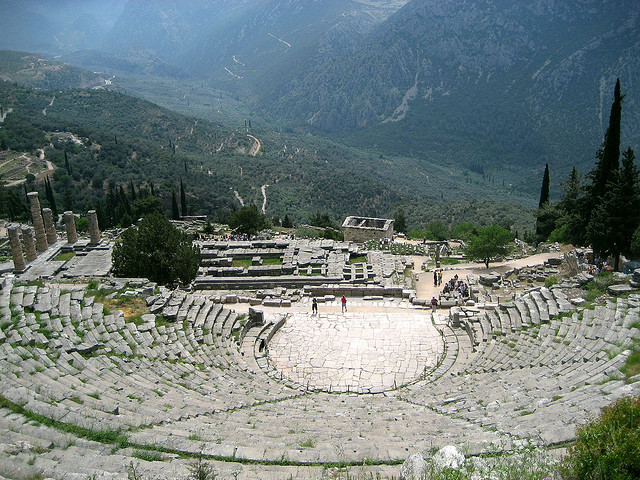
Find Best Hotel Deals in Delphi!
[/one_third]
[two_third_last valign=”top” animation=”none”]
Delphi Theatre
Delphi is both an archaeological site and a modern town in Greece on the south-western spur of Mount Parnassus in the valley of Phocis. In myths dating to the classical period of Ancient Greece (510-323 BCE), the site of Delphi was believed to be determined by Zeus when he sought to find the centre of his “Grandmother Earth” (Ge, Gaea, or Gaia). He sent two eagles flying from the eastern and western extremities, and the path of the eagles crossed over Delphi where the omphalos, or navel of Gaia was found.
Earlier myths include traditions that Pythia, or the Delphic oracle, already was the site of an important oracle in the pre-classical Greek world (as early as 1400 BCE) and, rededicated, served as the major site during classical times for the worship of the god Apollo after he slew Python, “a dragon” who lived there and protected the navel of the Earth. “Python” (derived from the verb pythein, “to rot”) is claimed by some to be the original name of the site in recognition of Python which Apollo defeated. The Homeric Hymn to Delphic Apollo recalled that the ancient name of this site had been Krisa. Others relate that it was named Pytho and that Pythia, the priestess serving as the oracle, was chosen from their ranks by a group of priestesses who officiated at the temple.
Apollo’s sacred precinct in Delphi was a panhellenic sanctuary, where every four years, starting in 586 BCE athletes from all over the Greek world competed in the Pythian Games, one of the four panhellenic (or stephanitic) games, precursors of the Modern Olympics. The victors at Delphi were presented with a laurel crown (stephanos) which was ceremonially cut from a tree by a boy who re-enacted the slaying of the Python. Delphi was set apart from the other games sites because it hosted the mousikos agon, musical competitions.
These Pythian Games rank second among the four stephanitic games chronologically and based on importance. These games, though, were different from the games at Olympia in that they were not of such vast importance to the city of Delphi as the games at Olympia were to the area surrounding Olympia. Delphi would have been a renowned city whether or not it hosted these games; it had other attractions that led to it being labeled the “omphalos” (navel) of the earth, in other words, the center of the world.
In the inner hestia (“hearth”) of the Temple of Apollo, an eternal flame burned. After the battle of Plataea, the Greek cities extinguished their fires and brought new fire from the hearth of Greece, at Delphi; in the foundation stories of several Greek colonies, the founding colonists were first dedicated at Delphi.
[/two_third_last]
[one_third valign=”top” animation=”none”]

Find Best Hotel Deals in Meteora! …or near Meteora.
[/one_third]
[two_third_last valign=”top” animation=”none”]
Meteora
The Metéora is one of the largest and most important complexes of Eastern Orthodox monasteries in Greece, second only to Mount Athos. The six monasteries are built on natural sandstone rock pillars, at the northwestern edge of the Plain of Thessaly near the Pineios river and Pindus Mountains, in central Greece. The nearest town is Kalambaka. The Metéora is included on the UNESCO World Heritage List under criteria I, II, IV, V and VII.
The Theopetra caves 5 kilometres (3.1 mi) south of Meteora had inhabitants fifty millennia ago. The oldest known example of a man-made structure was found within a prehistoric cave in central Greece, according to the Greek culture ministry. The structure is a stone wall that blocked two-thirds of the entrance to the Theopetra cave near Kalambaka on the north edge of the Thessalian plain. It was constructed 23,000 years ago, probably as a barrier to cold winds. “An optical dating test, known as Optically Stimulated Luminescence, was applied on quartz grains nested within the stones. We dated four different samples from the sediment and soil materials, and all provided identical dates,” Nikolaos Zacharias, director of the laboratory of archaeometry at the University of Peloponnese, told Discovery News. According to a statement by the ministry of culture, “the dating matches the coldest period of the most recent ice age, indicating that the cavern’s inhabitants built the stone wall to protect themselves from the cold.” Excavated since 1987, the Theopetra cave is well known to palaeontologists as it was used and inhabited continuously from the Palaeolithic period onwards (50,000 to 5,000 years ago).
In the 9th century, an ascetic group of hermit monks moved up to the ancient pinnacles.
They were the first people to inhabit Metéora. They lived in hollows and fissures in the rock towers, some of which reach 1800 ft (550m) above the plain. This great height, combined with the sheerness of the cliff walls, kept away all but the most determined visitors. Initially the hermits led a life of solitude, meeting only on Sundays and special days to worship and pray in a chapel built at the foot of a rock known as Dhoupiani. As early as the 11th century AD hermit monks were believed to be living among the caves and cutouts in the rocks.
The exact date of the establishment of the monasteries is unknown. By the late 11th and early 12th centuries, a rudimentary monastic state had formed called the Skete of Stagoi and was centered around the still-standing church of Theotokos (mother of God). By the end of the 12th century, an ascetic community had flocked to Metéora.
In 1344, Athanasios Koinovitis from Mount Athos brought a group of followers to Metéora. From 1356 to 1372, he founded the great Meteoron monastery on Broad Rock, which were perfect for the monks; they were safe from political upheaval and had complete control of the entry to the monastery. The only means of reaching it was by climbing a long ladder, which was drawn up whenever the monks felt threatened.
At the end of the 14th century, the Byzantine Empire’s 800-year reign over northern Greece was being increasingly threatened by Turkish raiders who wanted control over the fertile plain of Thessaly. The hermit monks, seeking a retreat from the expanding Turkish occupation, found the inaccessible rock pillars of Meteora to be an ideal refuge. More than 20 monasteries were built, beginning in the 14th century. Six remain today. There is a common belief that Athanasios (founder of the first monastery) did not scale the rock, but was carried there by an eagle.
In 1517, Nectarios and Theophanes built the monastery of Varlaám, which was reputed to house the finger of St John and the shoulder blade of St Andrew.
Access to the monasteries was originally (and deliberately) difficult, requiring either long ladders lashed together or large nets used to haul up both goods and people. This required quite a leap of faith – the ropes were replaced, so the story goes, only “when the Lord let them break”. In the words of UNESCO, “The net in which intrepid pilgrims were hoisted up vertically alongside the 373 metres (1,224 ft) cliff where the Varlaam monastery dominates the valley symbolizes the fragility of a traditional way of life that is threatened with extinction.” In the 1920s there was an improvement in the arrangements. Steps were cut into the rock, making the complex accessible via a bridge from the nearby plateau. During World War II the site was bombed.[citation needed][/citation] Many art treasures were stolen.[citation needed][/citation]
Until the 17th century, the primary means of conveying goods and people from these eyries was by means of baskets and ropes.
Six of the monasteries remain today. Of these six, four were inhabited by men, and two by women. Each monastery has fewer than 10 inhabitants. The monasteries are now tourist attractions.
[/two_third_last]
[one_third valign=”top” animation=”none”]
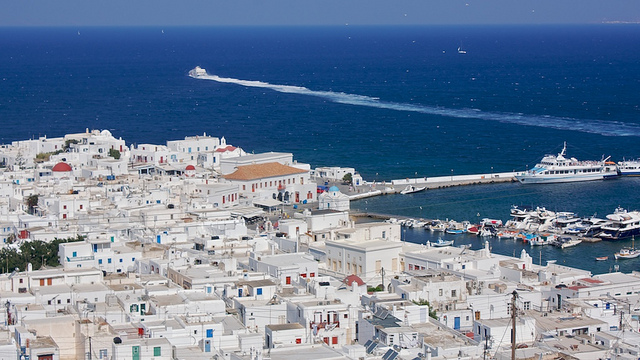
Find Best Hotel Deals in Mykonos!
[/one_third]
[two_third_last valign=”top” animation=”none”]
Mykonos
Mykonos is a Greek island, part of the Cyclades, lying between Tinos, Syros, Paros and Naxos. The island spans an area of 85.5 square kilometres (33.0 sq mi) and rises to an elevation of 341 metres (1,119 feet) at its highest point. There are 10,134 inhabitants (2011 census) most of whom live in the largest town, Mykonos, which lies on the west coast. The town is also known as Chora (i.e. the Town in Greek, following the common practice in Greece when the name of the island itself is the same as the name of the principal town).
Mykonos’ nickname is The island of the winds. Tourism is a major industry.
Archaeological findings suggest the presence of the Neolithic tribe Kares on the island in 3000 BC, but the first real settlers seem to be the Ionians from Athens in the early 11th century BC. There were many people living on the neighbouring island of Delos, just 2 km (1.2 miles) away, which meant that Mykonos became an important place for supplies and transit. It was, however, during ancient times a rather poor island with limited agricultural resources and only two towns. Its inhabitants were pantheists and worshipped many gods.
Mykonos came under the control of the Romans during the reign of the great Roman Empire and then became part of the Byzantine Empire until the 12th century. In 1204, with the fall of Constantinople in the Fourth Crusade, Mykonos was occupied by Andrea Ghisi, a relative of the Doge of Venice. The island was ravaged by the Catalans at the end of the 13th century and finally given over to direct Venetian rule in 1390.
In 1537, while the Venetians still reigned, Mykonos was attacked by Hayreddin Barbarossa, the infamous admiral of Suleiman the Magnificent, and an Ottoman fleet established itself on the island. The Ottomans, under the leadership of Kapudan Pasha, imposed a system of self-governance comprising a governor and an appointed council of syndics. When the castle of Tinos fell to the Ottomans in 1718, the last of the Venetians withdrew from the region.
Up until the end of the 18th century, Mykonos prospered as a trading centre, attracting many immigrants from nearby islands, in addition to regular pirate raids.
Portrait of Manto Mavrogenous at the Aegean Maritime Museum in Mykonos
The Greek Revolution against the Ottoman empire broke out in 1821 and Mykonos played an important role, led by the national heroine, Manto Mavrogenous. Mavrogenous, a well-educated aristocrat guided by the ideas of the Enlightenment, sacrificed her family’s fortune for the Greek cause. Greece became an independent state in 1830. A statue of her sits in the middle of Mando Mavrogenous square in the main town.
As a result of sailing and merchant activity, the island’s economy quickly picked up but declined again during the late 19th century and especially after the opening of the Corinth Canal in 1904 and the First World War at the beginning of the 20th century. Many Mykonians left the island to find work in mainland Greece and many foreign countries, especially the United States.
Tourism soon came to dominate the local economy, owing a lot to the important excavations carried out by the French School of Archaeology, which was began work in Delos in 1873.
In the 1930s many famous artists, politicians and wealthy Europeans began spending their vacations on the island and Mykonos quickly became an international hot spot. Temporarily suspended during the Second World War, tourists once again rushed to Mykonos’ luxurious shores in the 1950s and have not stopped since.
In Greek mythology, the Mykonos was named after its first ruler, Mykons, the son or grandson of the god Apollo and a local hero. The island is also said to have been the location of a great battle between Zeus and Titans and where Hercules killed the invincible giants having lured them from the protection of Mount Olympus. It is even said that the large rocks all over the island are the petrified testicles (or, in bowdlerized versions of the myth, the entire corpses) of the giants; this portion of the myth is the source of the slang term “stones” attested in most major European languages.
[/two_third_last]
[one_third valign=”top” animation=”none”]
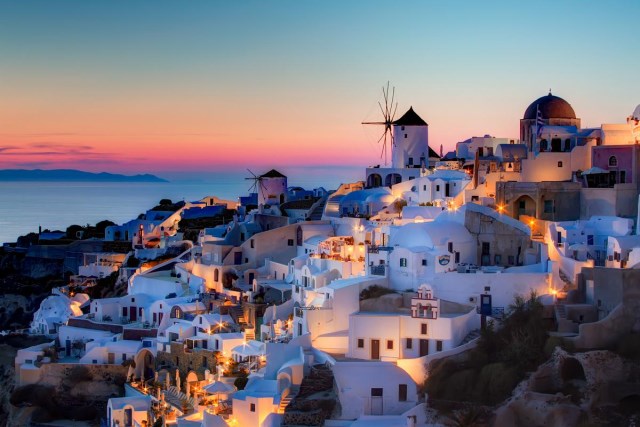
Find Best Hotel Deals in Santorini!
[/one_third]
[two_third_last valign=”top” animation=”none”]
Santorini
Santorini , classically Thera , and officially Thira ; is an island in the southern Aegean Sea, about 200 km (120 mi) southeast of Greece’s mainland. It is the largest island of a small, circular archipelago which bears the same name and is the remnant of a volcanic caldera. It forms the southernmost member of the Cyclades group of islands, with an area of approximately 73 km2 (28 sq mi) and a 2011 census population of 15,550. The municipality of Santorini comprises the inhabited islands of Santorini and Therasia and the uninhabited islands of Nea Kameni, Palaia Kameni, Aspronisi, and Christiana. The total land area is 90.623 km2 (34.990 sq mi). Santorini is part of the Thira regional unit.
Santorini is essentially what remains after an enormous volcanic eruption that destroyed the earliest settlements on a formerly single island, and created the current geological caldera. A giant central, rectangular lagoon, which measures about 12 by 7 km (7.5 by 4.3 mi), is surrounded by 300 m (980 ft) high, steep cliffs on three sides. The main island slopes downward to the Aegean Sea. On the fourth side, the lagoon is separated from the sea by another much smaller island called Therasia; the lagoon is connected to the sea in two places, in the northwest and southwest. The depth of the caldera, at 400m, makes it possible for all but the largest ships to anchor anywhere in the protected bay; there is also a newly built marina at Vlychada, on the southwestern coast. The island’s principal port is Athinias. The capital, Fira, clings to the top of the cliff looking down on the lagoon. The volcanic rocks present from the prior eruptions feature olivine and have a small presence of hornblende.
It is the most active volcanic centre in the South Aegean Volcanic Arc, though what remains today is chiefly a water-filled caldera. The volcanic arc is approximately 500 km (310 mi) long and 20 to 40 km (12 to 25 mi) wide. The region first became volcanically active around 3–4 million years ago, though volcanism on Thera began around 2 million years ago with the extrusion of dacitic lavas from vents around the Akrotiri.
The island is the site of one of the largest volcanic eruptions in recorded history: the Minoan eruption (sometimes called the Thera eruption), which occurred some 3600 years ago at the height of the Minoan civilization. The eruption left a large caldera surrounded by volcanic ash deposits hundreds of metres deep and may have led indirectly to the collapse of the Minoan civilization on the island of Crete, 110 km (68 mi) to the south, through a gigantic tsunami. Another popular theory holds that the Thera eruption is the source of the legend of Atlantis.
[/two_third_last]
[divider style=”simple” icon=”plane”]
[/divider]
[two_third valign=”top” animation=”none”]
You Need More?
You can save money on Last Minute Flights or Any Flight Ticket, on Car Rental and also on Lufthansa Deals (including Hotel, Flight and Car).
Find what fits to your needs in any destination you choose in Greece!
[/two_third]
[one_third_last valign=”top” animation=”none”]

[/one_third_last]
